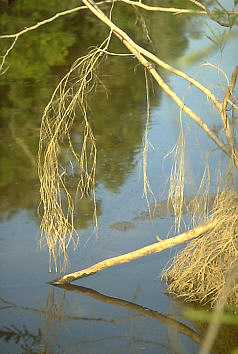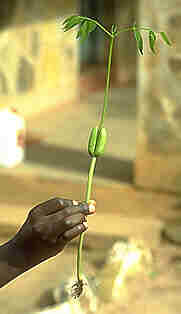Roots, the lower, underground part of a plant are characterized by their lack of leaves. They are the structures that function to take up water, nutriments and minerals from the soil. The primary root is the main axis of a root system. Mostly, it bears thinner side-roots. Special types of primary roots are tap roots or turnips. Adventitious roots are roots originating directly from the stem.
 The
most striking morphological feature of roots is their lack of leaves.
Roots are organized into primary
roots and side-roots.
The latter may develop a frequently branched and extensive root
system. Among the prominent types of roots are the tap roots where
the primary root is dominant while the side-roots are hardly
developed at all. The primary root grows deep into the soil. Swollen
roots that have developed into storage organs are called
turnips. Their formation may
involve the hypocotyl ( the part between the neck of the root and the
part where the leaves insert; see picture: an extremely long
hypocotyl, cotyledons and primary leaves of an African leguminosa).
Swollen side-roots can also become storage organs (tubers).
The
most striking morphological feature of roots is their lack of leaves.
Roots are organized into primary
roots and side-roots.
The latter may develop a frequently branched and extensive root
system. Among the prominent types of roots are the tap roots where
the primary root is dominant while the side-roots are hardly
developed at all. The primary root grows deep into the soil. Swollen
roots that have developed into storage organs are called
turnips. Their formation may
involve the hypocotyl ( the part between the neck of the root and the
part where the leaves insert; see picture: an extremely long
hypocotyl, cotyledons and primary leaves of an African leguminosa).
Swollen side-roots can also become storage organs (tubers).
 The
root-system of many monocots (like, that of the poaceae,for example)
is completely formed from adventitious roots.
Adventitious roots are roots that
originate directly at the shoot. Rhizomes and shoots that touch the
soil are able to form adventive roots. This fact is used to propagate
plants vegetatively through cuttings (parts with nodes in them).
The
root-system of many monocots (like, that of the poaceae,for example)
is completely formed from adventitious roots.
Adventitious roots are roots that
originate directly at the shoot. Rhizomes and shoots that touch the
soil are able to form adventive roots. This fact is used to propagate
plants vegetatively through cuttings (parts with nodes in them).
Epiphytes do often develop air
roots. They are, just like usual roots able to take up minerals
and rain water and sometimes they can even perform
photosynthesis.

Click in the picture to open an AVI file, click again to observe the growth following the water distribution
The picture shows a two-dimensional model of a root seeking water in the soil during its development. The initial water distribution has been predetermined, forming an S-shaped zone of high concentration indicated by the light colour. The growing tips of the main root and rootlets absorb water that diffuses in the soil. The decreased water concentration is indicated by dark areas that emerge around the root system. In areas with insufficient water concentration the rootlets cease to grow before they have reached their potential full length. (from the Virtual Laboratory).
|
|